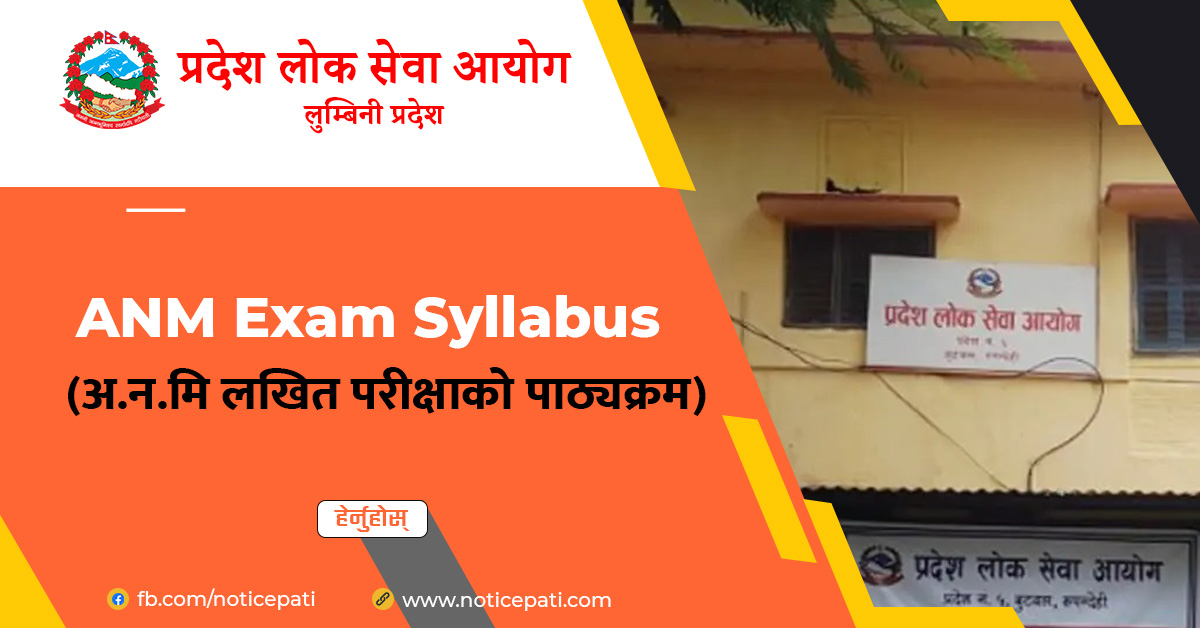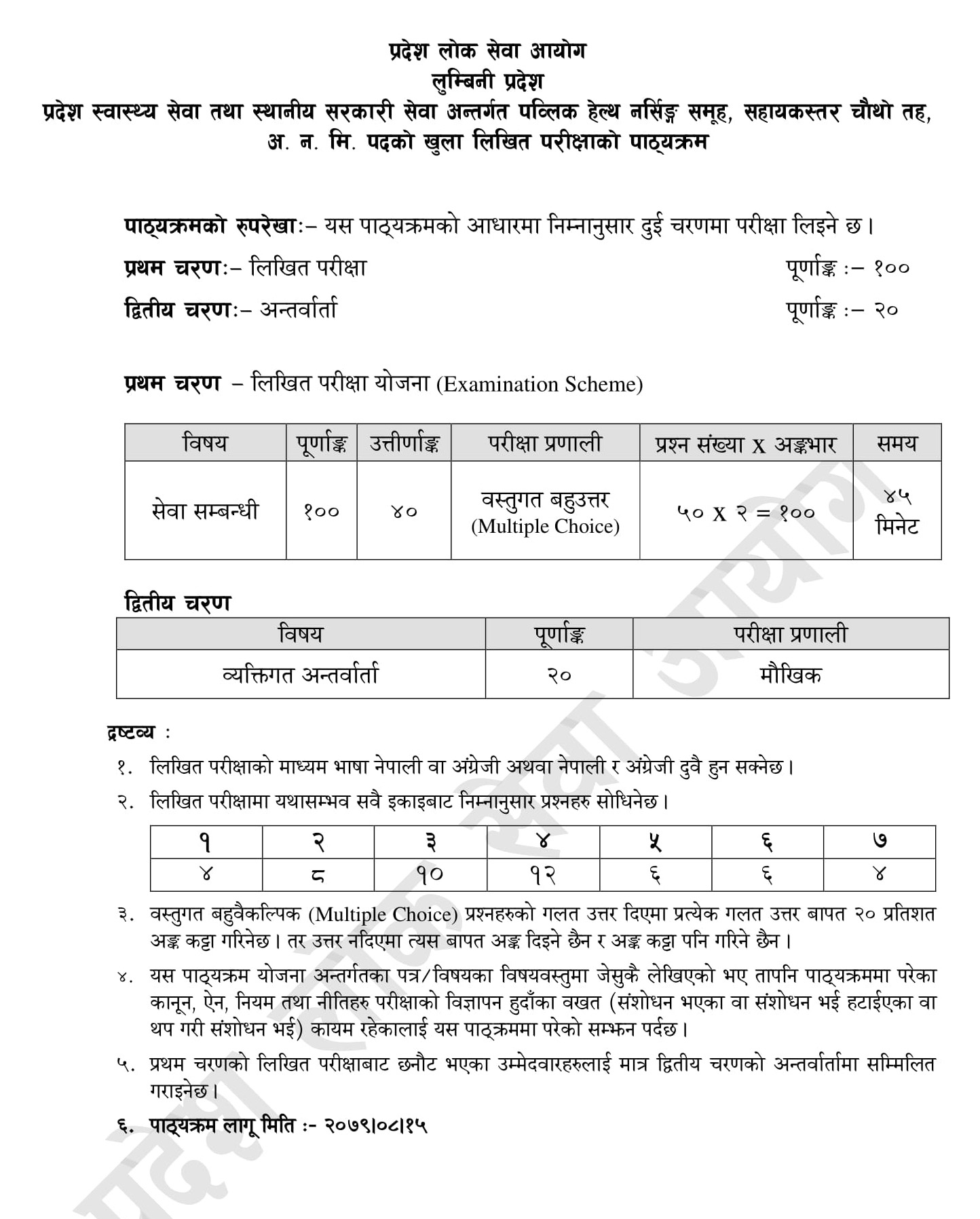

Lumbini Pradesh Lok Sewa Aayog 4th Level ANM Exam Syllabus: Lok Sewa Aayog (Public Service Commission) Lumbini Pradesh has released has released ANM for Assistant 4th level of new syllabus.
Syllabus of open written examination for public health nursing group, assistant 4th level, ANM post under Province health service and local government service.
Syllabus Outline:- Based on this syllabus, the examination will be conducted in two stages as follows.
First Stage:- Written Exam, Marks: 100
Second stage:- Interview, Marks: 20
First Phase:- Written Examination Scheme
| Subject | Service related |
| Full Marks | 100 |
| Pass Marks | 40 |
| Exam System | Multiple Choice |
| Number of Questions × Mark | 50×2=100 |
| Time | 45 Minutes |
Second stage:- Interview
| Subject | Individual |
| Marks | 20 |
| Exam System | Interview |
 1. Anatomy and Physiology
1. Anatomy and Physiology1.1. Names, types and functions of the different organs of following system
1.1.1. Terms used in anatomy and physiology
1.1.2. Cell and tissue
1.1.3. Skeletal System
1.1.4. Muscular System
1.1.5. Digestive System
1.1.6. Circulatory System
1.1.7. Urinary System
1.1.8. Nervous System
1.1.9. Respiratory System
1.1.10. Endocrine System
1.1.11. Sensory Organs
1.2. Mechanism of the different system
1.2.1. Mechanism of digestion of food
1.2.2. Mechanism of respiration
1.2.3. Mechanism of menstrual cycle
1.2.4. Mechanism of urinary system
1.2.5. Mechanism of fluid and electrolyte balance
2.1. Roles and responsibilities of ANM in different health care institution and community
2.2. Ethical and legal responsibilities of nurse
2.3. Types of hospital
2.4. Nursing process
2.5. Basic needs
2.6. Comfort measures
2.7. Nutritional and elimination needs
2.8. Fluid and electrolyte balance
2.9. infection prevention and control measures
2.10. Drug administration
2.11. Wound care, heat and cold application, exercise
2.12. First aid treatment; definition principles and qualities of good first aider, first aid management of different conditions /problems
2.13. Care of dead body
3.1. Various terms related to community health
3.2. Factors influencing health
3.3. level of disease prevention
3.4. Primary health care
3.4.1. Principles of PHC
3.4.2. Elements of PHC
3.4.3. Role of ANM in HP/PHCC
3.5. Health education and Communication
3.5.1. Principle and importance of health education
3.5.2. Types, methods and media of health education
3.5.3. Elements, barriers and techniques of communication
3.6.Home visiting
3.6.1. Introduction
3.6.2. purpose and principles
3.6.3. advantages
3.6.4. steps
3.6.5. home visit bag technique/ kit
3.7. Epidemiology and communicable diseases
3.7.1. Epidemiological traid
3.7.2. Definition and aims of epidemiology
3.7.3. Concept of diseases
3.7.4. Communicable diseases and its prevention, control and treatment including Acquired Immune Deficiency Syndrome (AIDS) and Sexual Transmitted Disease (STDs)
3.8. Immunization/ vaccination
3.8.1. concept of immunity
3.8.2. types of vaccine
3.8.3. vaccine schedule
3.8.4. cold chain
3.9. Nutrition related to health
3.9.1. Categories types of food, macro and micronutrients
3.9.2. Nutritional health status of women and children in Nepal
3.9.3. Importance of nutrition on the growth and development of the body
3.9.4. Nutritional requirement in normal children, young, adult, adulthood, pregnancy and lactating mother
3.9.5. Nutrition deficiency disease
3.9.6. Breast feeding and weaning
3.9.7. Food hygiene and preservation
3.10. Family planning
3.10.1. Temporary methods for male and female
3.10.2. Permanent methods for male and female
3.10.3. Family planning counseling
3.10.4. Various rates and ratio used in population education
3.11. Environmental Sanitation
3.11.1. Health problems and diseases due to poor environmental Sanitation
3.11.2. Water pollution
3.11.3. Excreta disposal and its importance
3.11.4. Types of latrines
3.11.5. Classification and management of solid waste disposal
3.11.6. Water born disease
4.1. Antenatal care (ANC)
4.1.1. Reproductive health and adolescent reproductive health
4.1.2. Women's health problems
4.1.3. Concept of safe motherhood
4.1.4. Abortion and sub-fertility
4.1.5. Function of placenta and its types
4.1.6. Physiological changes during pregnancy
4.1.7. Signs and symptoms of pregnancy.
4.1.8. Antenatal care and antenatal visit
4.1.9. Calculation of Last Menstrual Period (LMP) and Expected Date of Delivery
(EDD) and gestational week of pregnancy
4.1.10. Investigations during pregnancy
4.1.11. Health teaching during antenatal visit
4.1.12. Minor and Major disorders during pregnancy its management
4.1.13. High risk factors during pregnancy and their management
4.1.14. High risk mother
4.2. Labour care(Intranatal care)
4.2.1. Normal labour
4.2.2. Signs & symptoms; and causes of onset of labour
4.2.3. Physiological changes during first, second and third stages of labour
4.2.4. Management of 1st, 2nd, 3rd and 4th stages labour
4.2.5. Indications and time of episiotomy
4.2.6. Method of scoring of the APGAR score
4.2.7. Immediate care of newborn baby
4.2.8. Examination of newborn baby
4.2.9. Complication of second and third stage of labour and its management
4.2.10. Signs and symptoms and management of maternal and foetal distress
❖ Occipito posterior position
❖ Multiple pregnancy
❖ Mal presentation
❖ Prematurity
❖ Post maturity
4.2.12. Management of prolonged labour
❖ Cephalo pelvis disproportion (CPD)
❖ Trial labour (Induction)
❖ Instrumental Delivery
4.3. Postnatal care
4.3.1. Definition, Principles and purpose of postnatal care
4.3.2. Minor disorders during puerperium (After pain, retention of urine, constipation, Haemorrhoid, Crack nipple, Engorge breast, Sub-involution of the Uterus)
4.3.3. Major disorder during puerperium
❖ Puerperal sepsis
❖ Urinary Tract Infection (UTI)
❖ Incontinence of urine and stool
❖ Puerperal hemorrhage
❖ Venus thrombosis
❖ Pulmonary embolism
❖ Postnatal psychosis and depression
❖ Post-partum eclampsia
❖ Major disorders of new born and its management
5.1. Definition of terms
5.1.1. Neonate
5.1.2. Infant
5.1.3. Toddler
5.1.4. Preschool
5.1.5. School age
5.1.6. Adolescence
5.2. Growth, development and milestone
5.3. Child assessment and anthropometry; height, weight and MUAC
5.4. Common causes of child and neonatal mortality in Nepal, concept of 5 major killer
disease and IMCI, CBIMNCI
5.5. Common health hazards and health problems in children in Nepal
5.6. Common health problems of adolescents
6.1. Different types of microorganisms including spore and parasites
6.2. Method of sample collection
6.3. Forms of drug and its classification; drug and alcohol
dependence
6.4. Nursing management of following conditions:
6.4.1. Diabetes
6.4.2. Hypo and hyperthyroidism
6.4.3. Peptic ulcer
6.4.4. Jaundice
6.4.5. Typhoid
6.4.6. Hepatitis
6.4.7. Diarrhea/dysentery
6.4.8. Bronchial Asthma
6.4.9. Bronchitis
6.4.10. Tuberculosis
6.4.11. COPD
6.4.12. Pneumonia
6.4.13. Anemia
6.4.14. Hypertension
6.4.15. Congestive cardiac failure
6.4.16. Rheumatic fever and heart disease
6.4.17. Sexually Transmitted Disease (STD)
6.4.18. Urinary Tract Infection
6.4.19. Nephritis
6.4.20. Renal failure
6.4.21. Renal calculi
6.4.22. Meningitis, Encephalitis
6.4.23. Paralysis
6.4.24. Head injury, spinal cord injury
6.4.25. CVA
6.4.26. Common eye and skin problems
6.4.27. Mental Health (Types and causes of mental problem)
6.4.28. Nephrotic syndrome
Here we have shared Lumbini Pradesh Lok Sewa Aayog 4th Level ANM Exam Syllabus .pdf File. You can easily download and read Lumbini Pradesh ANM Exam Syllabus to get success in PSC exam.